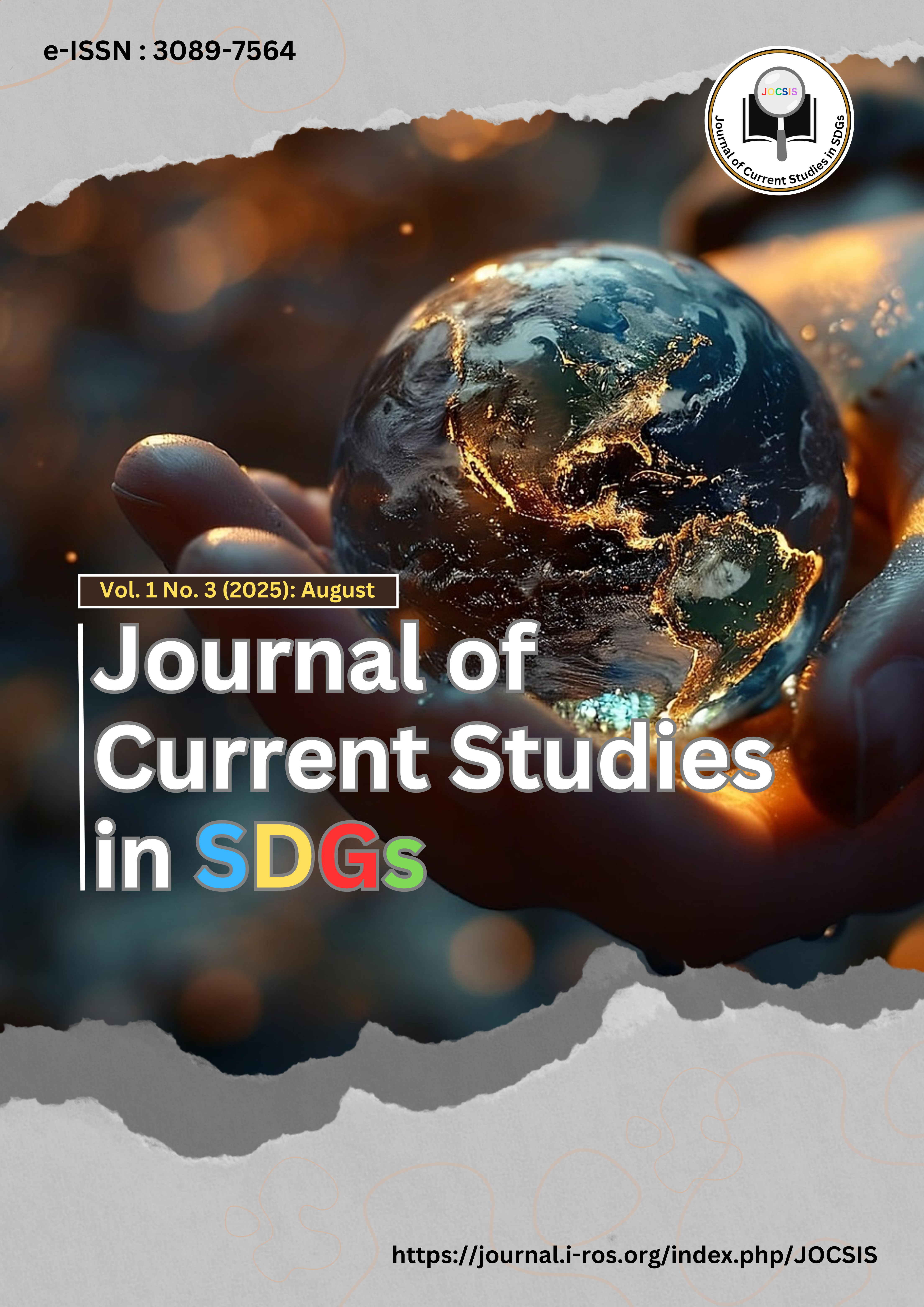Theoretical Review: Adiabatic Coupler Engineering and Modification in Supporting SDGs 9 Efficient Optic Technology Engineering and Innovation
DOI:
https://doi.org/10.63230/jocsis.1.3.91Keywords:
Adiabatic, Adiabaticity, Coupler, Optical, PhythonAbstract
Objective: This study aims to describe the application of adiabatic coupler modification in efficient optical coupler engineering and to emphasize its contribution to the achievement of SDG 9 (Industry, Innovation, and Infrastructure). Method: The method used is a literature study through a review of relevant articles and Python software-based analysis to evaluate the impact of coupler modifications, as an effort to strengthen theoretical findings. Results: The results of this study show that the invariance principle-based reverse engineering approach is practical in designing directional couplers on waveguides. Combined with perturbation analysis of the coupled mode equations, this method produces directional couplers that are highly robust to parameter variations such as coupling coefficient and wavelength. However, changes in scale or resonance through Python integration do not significantly affect the apparent deviation of the coupler wave, so the efficiency of the coupler is mainly determined by the coupling coefficient and wavelength variations. Novelty: This study highlights the novelty of utilizing the invariance principle and resonance modification as an efficient and straightforward approach for adiabatic coupler optimization. Furthermore, the results demonstrate the significant contribution of adiabatic couplers to SDG 9 through their support for the development of sustainable optical communication infrastructure, increased energy efficiency, and innovation in next-generation optical technologies.
References
Agrell, E., Arockiaraj, F. G., Pristy, A., Xavier, I., Agrell, E., Karlsson, M., Poletti, F., Namiki, S., Chen, X. V., Rusch, L. A., Puttnam, B., Bayvel, P., Schmalen, L., Tao, Z., Kschischang, F. R., & Alvarado, A. (2024). Roadmap on optical communications. Journal of Optics, 26, 93001.
Benton, D., Li, Y., Billaud, A., & Ellis, A. (2024). Spatial mode division multiplexing of free-space optical communications using a pair of multiplane light converters and a micromirror array for turbulence emulation. Photonics, 11(3). https://doi.org/10.3390/photonics11030241
Cortella, G., D’Agaro, P., & Coppola, M. A. (2020). Transcritical CO2 commercial refrigeration plant with adiabatic gas cooler and subcooling via HVAC: Field tests and modelling. International Journal of Refrigeration, 111(June), 71–80. https://doi.org/10.1016/j.ijrefrig.2019.11.022
Dzhunushalieva, G., Teuber, R. (2024). Roles of innovation in achieving the sustainable development goals: A bibliometric analysis. Journal of Innovation & Knowledge. 3(2), 12. https://doi.org/10.1016/j.jik.2024.100472
Fitroni, W., Ramadani, Y.S., Cahya, R.D., Rosyadi, M.R.E. (2025). Literature review: the use of professional technology in the integration of ESD (education for sustainable development) in social science learning. Journal of Innovative Technology and Sustainability Education, 1(2), 79. https://doi.org/10.63230/jitse.1.2.79
Hadi, H. K., Irawan, M. I., Nadlifatin, R., Cahigas, M. M. L., & Safitri, A. (2024). Trend and research the use of virtual reality to increase student’s negotiation skills in realizing Sustainability. E3S Web of Conferences, 568. https://doi.org/10.1051/e3sconf/202456802001
Han, Q., Wang, J., Tian, S., Hu, S., Wu, X., Bai, R., Zhao, H., Zhang, D. W., Sun, Q., & Ji, L. (2024). Inorganic perovskite-based active multifunctional integrated photonic devices. Nature Communications, 15(1), 1–9. https://doi.org/10.1038/s41467-024-45565-9
Indahwati, S. D., Rachmadiarti, F., Hariyono, E., Prahani, B. K., Wibowo, F. C., Bunyamin, M. A. H., & Satriawan, M. (2023). Integration of independent learning and physics innovation in STEAM-based renewable energy education to improve critical thinking skills in the era of Society 5.0 for Sustainable Development Goals (SDGs) 2030. E3S Web of Conferences, 450, 2025. https://doi.org/10.1051/e3sconf/202345001010
Liang, T. L., Cheng, X., Yu, M., Zhang, L., Shi, J., Wang, B., ... & Shao, W. (2024). Design of efficient and compact adiabatic couplers based on adiabatic mode evolutions. Optics & Laser Technology, 174, 110659. https://doi.org/10.1016/j.optlastec.2024.110659
Lintangesukmanjaya, R.T., Dwikoranto, Awwalina, D.P., Setiani, R., Bergsma, L.N. (2025). Potential study SDGs 4 of deep learning approaches to improve problem solving with machine learning inovation: empirical and bibliometric analysis. E3S Web of Conferences, 640, 02018. https://doi.org/10.1051/e3sconf/202564002018
Lintangesukmanjaya, R.T., Prahani, B.K., Dwikoranto, Alhusni, H.Z., & Kurtuluş, M.A. (2025). Technology integration for SDGs-oriented social science education: a bibliometric perspective. E3S Web of Conferences, 640, 02017. https://doi.org/10.1051/e3sconf/202564002017
Longhi, S. (2009). Quantum‐optical analogies using photonic structures. Laser & Photonics Reviews, 3(3), 243–261.
Lyytimäki, J. (2024). Sustainable development goals relighted: light pollution management as a novel lens to SDG achievement. Discover Sustainability. https://doi.org/10.1007/s43621-025-00991-7
Mishra, P., & Singh, G. (2023). Energy management systems in sustainable smart cities based on the internet of energy: A technical review. Energies, 16(19), 6903. https://doi.org/10.3390/en16196903
Neder, I., Sirote-Katz, C., Geva, M., Lahini, Y., Ilan, R., & Shokef, Y. (2024). Bloch oscillations, Landau–Zener transition, and topological phase evolution in an array of coupled pendula. Proceedings of the National Academy of Sciences, 121(9), e2310715121. https://doi.org/10.1073/pnas.2310715121
Osornio-Martinez, C. E., Bonneville, D. B., & Coulaud, Q. (2025). Monolithically Integrated Erbium-Doped Polycrystalline Al2O3 Waveguide Amplifier on Silicon Photonics Platform. Optics Express, 33(11), 23491–23502.
Paloczi, G. T., Eyal, A., & Yariv, A. (2004). Wavelength-insensitive nonadiabatic mode evolution couplers. IEEE Photonics Technology Letters, 16(2), 515–517. https://doi.org/10.1109/LPT.2003.821254
Ramadan, T. A., Scarmozzino, R., & Osgood, R. M. (1998). Adiabatic couplers: Design rules and optimization. Journal of Lightwave Technology, 16(2), 277–283. https://doi.org/10.1109/50.661021
Su, G., Chen, H., Fu, X., Yang, L. (2025). Compact polarization-insensitive 2 × 2 3 dB quasi-adiabatic coupler based on shape optimization. Photonics, 12(3), 208. https://doi.org/10.3390/photonics12030208
Syahriar, A., Schneider, V. M., & Al-Bader, S. (1998). The design of mode evolution couplers. Journal of Lightwave Technology, 16(10), 1907–1914. https://doi.org/10.1109/50.721079
Wang, Y., Benny, A., Le Dé, B., Chin, A. W., & Scholes, G. D. (2025). A numerically exact description of ultrafast vibrational decoherence in vibration-coupled electron transfer. Proceedings of the National Academy of Sciences, 122(9), e2416542122. https://doi.org/10.1073/pnas.2416542122
Wu, J., Jia, L., Zhang, Y., Qu, Y., Jia, B., Moss, D.J. (2020). Graphene oxide films for ultra-flat optics and linear and nonlinear integrated photonic circuits. https://doi.org/10.48550/arXiv.2102.07251
Tseng, S.-Y. (2013). Counterdiabatic mode-evolution based coupled-waveguide devices. Optics Express, 21(18), 21224. https://doi.org/10.1364/oe.21.021224
Tseng, S.-Y., Wen, R.-D., Chiu, Y.-F., & Chen, X. (2014). Short and robust directional couplers designed by shortcuts to adiabaticity. Optics Express, 22(16), 18849. https://doi.org/10.1364/oe.22.018849
Downloads
Published
Issue
Section
License
Copyright (c) 2025 Journal of Current Studies in SDGs

This work is licensed under a Creative Commons Attribution 4.0 International License.
This work is licensed under a Creative Commons Attribution 4.0 International License.







